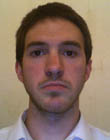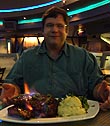|
|
 
|
|
Author
|
Topic: 'Ghosting' on DLP showings
|
|
|
|
|
|
|
|
|
Dick Vaughan
Phenomenal Film Handler

Posts: 1032
From: Bradford, West Yorkshire, UK
Registered: Jul 2000
|
 posted 07-23-2008 02:36 PM
posted 07-23-2008 02:36 PM





from in70mm.com
About Richard Vetter
1. I was appointed Director of the Todd-AO Camera Department in 1963. The main object was to update the 65mm system, to continue to provide equipment and services to the film industry and to integrate the cameras with Dimension 150 optical and projection systems. Between 1963 and 1971 several features were produced and released (Sound of Music in Todd-AO, The Bible in D-150, Hello Dolly in Todd-AO, Patton in D-150, The Last Valley in Todd-AO and Baraka in Todd-AO. Between 1969 and 1984 several World's Fair pictures were produced in D-150, Todd-AO and StereoSpace 3-D.
2. In the late 1960's we perceived that 70mm releases were fading and decided to develop a 35mm anamorphic system. In conjunction with NAC of Japan, I invented a superior optical system for which we received an Academy Award for its superiority: Todd-AO 35. Roman Polanski was the first to produce Macbeth in our new 35mm version in 1972. Sam Peckinpah, Dino de Laurentiis and other prominent producers used Todd-AO 35. The 35mm equipment and lenses were sold to Cinema Products in the late 1980.s. Todd-AO 35mm lenses continue to be used by Dino de Laurentiis and other producers. Over 40 feature films have been produced using Todd-AO 35 lenses.
3. I was concurrently Vice President and Technical Director for United Artists Theatres (parent owner of Todd-AO) from 1970 to 1997. We received numerous patents for improvements to production and exhibition equipment and systems.
4. Many skilled individuals contributed to Todd-AO: Mike Todd (the genius behind Todd-AO), Marshall and Robert Naify, Paul Neilsen, Douglas Fries, Dan Lemeiter, Darryl Gray, and the list goes on and on.
| IP: Logged
|
|
Galen Murphy-Fahlgren
Master Film Handler

Posts: 405
From: Canton, MI, USA
Registered: Oct 2007
|
 posted 07-23-2008 03:38 PM
posted 07-23-2008 03:38 PM




quote: Mark Gulbrandsen
Yes, but NO MORE than about 6 to 7 degrees angled as per Dr. Richard Vetter....
Mark
If you had a downward projector angle due to stadium seating, wouldn't you end up with vertical portholes? This is a concern of mine, since my ports are angled, I think, too steeply downwards, and my projectors are angled down as well, meaning that the port is angled probably 20 degrees off parallel with the film plane. With my understanding of optics, this causes unnecessary light loss on screen.
| IP: Logged
|
|
|
|
|
|
|
|
|
|
All times are Central (GMT -6:00)
|
|
Powered by Infopop Corporation
UBB.classicTM
6.3.1.2
The Film-Tech Forums are designed for various members related to the cinema industry to express their opinions, viewpoints and testimonials on various products, services and events based upon speculation, personal knowledge and factual information through use, therefore all views represented here allow no liability upon the publishers of this web site and the owners of said views assume no liability for any ill will resulting from these postings. The posts made here are for educational as well as entertainment purposes and as such anyone viewing this portion of the website must accept these views as statements of the author of that opinion
and agrees to release the authors from any and all liability.
|

 Home
Home
 Products
Products
 Store
Store
 Forum
Forum
 Warehouse
Warehouse
 Contact Us
Contact Us




 Printer-friendly view of this topic
Printer-friendly view of this topic
















